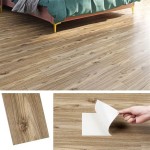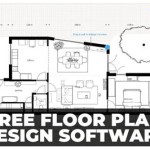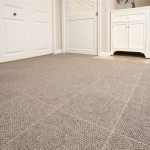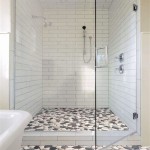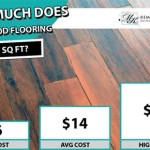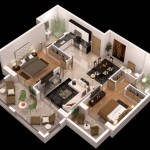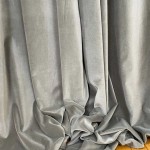Powder Room Tile Floor Ideas: Elevating Compact Spaces with Style
The powder room, often the smallest room in the house, presents a unique opportunity for design experimentation. Its compact size allows for bolder choices and a greater willingness to take risks with materials and patterns. The floor, in particular, is a key element in setting the tone and enhancing the aesthetic appeal of this space. Tile, with its versatility, durability, and wide range of design options, is an ideal choice for powder room flooring. This article explores various tile floor ideas to inspire and guide the selection process for creating a stylish and functional powder room.
When selecting tile for a powder room floor, several factors should be considered beyond aesthetics. These include the material's water resistance, slip resistance, durability, and ease of maintenance. Porcelain and ceramic tiles are popular choices due to their inherent water resistance and affordability. Natural stone tiles, such as marble and slate, offer a luxurious feel but require more maintenance and can be more porous. The size and shape of the tile also play a crucial role in the overall design, influencing the perceived size of the room and the complexity of the installation.
Key Considerations for Powder Room Tile Selection
Selecting the appropriate tile for a powder room requires careful consideration of several factors that go beyond mere aesthetics. These considerations ensure a floor that is not only visually appealing but also practical and long-lasting.
Material Properties: The material composition of the tile directly impacts its suitability for the powder room environment. Porcelain and ceramic tiles are known for their high water resistance, making them ideal for spaces prone to splashes and moisture. Porcelain, in particular, is denser and less porous than ceramic, offering superior stain resistance. Natural stone tiles, while visually stunning, require sealing to prevent water absorption and staining. The choice between these materials depends on the desired aesthetic, budget, and willingness to maintain the floor over time.
Slip Resistance: Safety is paramount, particularly in a small space where spills and dampness are common. Tile is rated for slip resistance using a Dynamic Coefficient of Friction (DCOF) rating. A higher DCOF rating indicates greater slip resistance. For powder rooms, tiles with a DCOF rating of 0.42 or higher are generally recommended to minimize the risk of slips and falls. Textured tiles inherently provide better slip resistance than smooth, polished surfaces.
Durability: Powder rooms experience moderate foot traffic, but the floor still needs to withstand daily use and potential impacts. The Porcelain Enamel Institute (PEI) rating measures a tile's resistance to abrasion. A PEI rating of 3 or higher is suitable for residential floors, including powder rooms. Tiles with a low PEI rating are more susceptible to scratches and wear, making them less suitable for flooring applications.
Maintenance: Ease of cleaning and maintenance is a key consideration for any floor covering. Porcelain and ceramic tiles are relatively easy to clean with mild soap and water. Natural stone tiles require specialized cleaning products to avoid damaging the sealant. The grout lines between tiles are also susceptible to staining and require regular cleaning and occasional sealing to maintain their appearance. Darker grout colors can help to minimize the visibility of stains.
Exploring Tile Design Ideas for Powder Rooms
The design possibilities for powder room tile floors are vast, allowing for the creation of a space that reflects individual style and complements the overall home decor. From classic patterns to bold colors and unique shapes, the choice of tile can transform a small, utilitarian space into a design statement.
Pattern and Layout: The pattern in which tiles are laid can significantly impact the visual appeal of the powder room. Classic patterns like herringbone, subway tile, and checkerboard can add a sense of timeless elegance. Creative layouts, such as a diagonal pattern or a mosaic border, can create visual interest and break up the monotony of a small space. Larger format tiles can minimize grout lines and create a more seamless, modern look. Consider the scale of the pattern in relation to the size of the room; smaller patterns can make a small space feel busier, while larger patterns can create a more spacious feel.
Color Palette: The color of the tile sets the overall mood and atmosphere of the powder room. Light, neutral colors, such as white, cream, and gray, can create a sense of spaciousness and brightness. Darker colors, such as black, navy, and charcoal, can create a more dramatic and intimate feel. Bold colors, such as jewel tones or vibrant hues, can add a pop of personality and create a focal point. Consider the existing color scheme of the adjoining rooms and choose a tile color that complements the overall design.
Tile Shape and Size: Beyond the standard square and rectangular tiles, there are numerous other shapes that can add visual interest to the powder room floor. Hexagon tiles, penny tiles, and Moroccan-inspired shapes can create a unique and eye-catching design. The size of the tiles also affects the overall aesthetic. Large format tiles can make a small space feel larger and more modern, while smaller tiles can create a more intricate and detailed look. Mixing different sizes and shapes of tiles can add depth and dimension to the floor.
Material Texture: The texture of the tile adds another layer of complexity to the design. Smooth, polished tiles offer a sleek and modern look, while textured tiles provide better slip resistance and add visual interest. Wood-look tiles can bring warmth and natural beauty to the space. Stone-look tiles can create a rustic and organic feel. Consider the overall style of the powder room and choose a tile texture that complements the design.
Specific Tile Flooring Ideas for Powder Rooms
To further illustrate the potential of tile in powder room design, here are some specific ideas that incorporate various design elements to create distinct styles and atmospheres.
Classic Black and White: A timeless combination, black and white tile offers a sophisticated and elegant look. A checkerboard pattern creates a classic and visually appealing design. Alternatively, large-format black tiles with white grout can create a modern and dramatic effect. The contrast between the black and white adds depth and dimension to the space, making it feel more spacious and inviting.
Mosaic Magic: Mosaic tiles, with their intricate patterns and vibrant colors, can transform a powder room floor into a work of art. Penny tiles, with their small, round shape, create a vintage-inspired look. Glass mosaic tiles add a touch of sparkle and glamour. Consider using mosaic tiles to create a border around the perimeter of the room or to define a specific area, such as the vanity.
Natural Stone Elegance: Natural stone tiles, such as marble, slate, and travertine, offer a luxurious and organic feel. Marble tiles, with their veining and natural variations, add a touch of timeless elegance. Slate tiles, with their textured surface and earthy tones, create a rustic and inviting atmosphere. Remember to seal natural stone tiles to protect them from water damage and staining.
Bold and Colorful Statements: Don't be afraid to experiment with bold and vibrant colors in the powder room. Brightly colored tiles can add a pop of personality and create a memorable space. Use colorful tiles to create a focal point or to define a specific area. Consider using a single color for the floor and then accenting with colorful accessories. Geometric patterned tiles featuring multiple colors are a popular and eye-catching option.
Wood-Look Warmth: Wood-look tiles offer the beauty of wood without the maintenance concerns. These tiles are incredibly durable and water-resistant, making them an ideal choice for powder rooms. Choose a wood-look tile that complements the overall style of your home. Lighter wood tones create a bright and airy feel, while darker wood tones create a more dramatic and intimate atmosphere. Lay the tiles in a traditional plank pattern or experiment with a herringbone pattern for added visual interest.
By carefully considering the material properties, slip resistance, durability, and maintenance requirements of different tile options, and by exploring various design ideas, homeowners can create a powder room floor that is both beautiful and functional. The powder room, despite its size, can become a showcase of style and design, reflecting the homeowner's personal taste and enhancing the overall aesthetic of the home.

Bathroom Floor Tiles Hexagon More The Tile Shop
:max_bytes(150000):strip_icc()/DesignbyEmilyBowser_Bathroom_PhotobySaraLigorria-Tramp_2-102f741f640e46c98536497eab40fe57.jpeg?strip=all)
43 Pretty Powder Room Ideas For Your Half Bath
45 Fantastic Bathroom Floor Ideas And Designs Renoguide N Renovation Inspiration

Big Tile Or Little How To Design For Small Bathrooms And Living Spaces Outlets Of America

10 Small Bathroom Flooring Ideas That Wow Jenna Kate At Home

Prepare To Be Amazed By These 13 Mosaic Bathroom Floor Tile Ideas Hunker

20 Best Bathroom Floor Tile Ideas Decoholic

Traditional Bathroom Ideas Designer Showhouse Style Calypso In The Country

Bathroom Floor Tiles Hexagon More The Tile Shop

Creative Bathroom Tile Design Ideas Tiles For Floor Showers And Walls In Bathrooms
